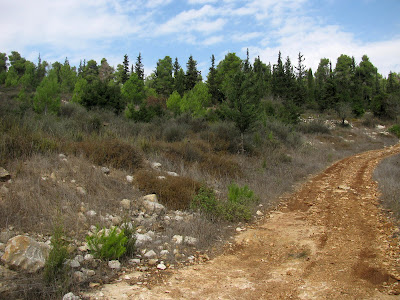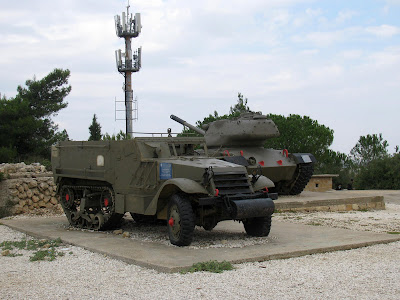The area of Ma'ale HaHamisha, Kiryat Anavim and Har Adar is an extremely beautiful part of the Jerusalem Hills. It is also rich in recent history. The British army, led by General Allenby, captured these hills from the Turks during World War I. During the period of the British mandate, one particular hill was thought to be a post for telecommunications that included radar antennas. For this reason, the Haganah and Palmach referred to it as Givat HaRadar or Radar Hill, although it was in fact only a relay station to boost the radio signal. The hill was also the scene of bitter fighting during Israel's War of Independence.

Our circular hike started off on the red trail in the HaHamisha Forest. From there we enjoyed wonderful views of the surrounding area including Kibbutz Kiryat Anavim, the Arab village of Abu Gosh and, on the other side of Road 1, Har Tzuva and the Crusader fortress of Belmont, which we had visited just a week earlier.
We turned off onto a portion of the the black-marked "1948 Trail" (שביל תש׳׳ח), which begins at Har Adar and continues to the cemetery at Kiryat Anavim. This trail was dedicated by the Jewish National Fund in 2012 and is intended to recollect the tough battles fought for control of this area during the War of Independence. Continuing up the hill we missed our next turn which should have taken us to a picnic area by the entrance to the town of Har Adar and ultimately to the Harel Monument on Radar Hill, but we found our way there anyway.
When the British left Palestine in May 1948 they handed Radar Hill over to the Jordanian Arab Legion. The Harel Brigade (Hativat Harel), headed by Yitzhak Rabin, who in later years became Israel's fifth Prime Minister, made 23 attempts to conquer the strategically important hill as part of the struggle for Jerusalem. The Harel Brigade held the position for only four days before finally being defeated. In the aftermath of its failure, a convoy of Palmach armoured vehicles approached Radar Hill from the south to try and rescue the fighters who were retreating under fire. These vehicles were stopped by the British who were stationed there and handed them over to the Arabs who murdered them.We turned off onto a portion of the the black-marked "1948 Trail" (שביל תש׳׳ח), which begins at Har Adar and continues to the cemetery at Kiryat Anavim. This trail was dedicated by the Jewish National Fund in 2012 and is intended to recollect the tough battles fought for control of this area during the War of Independence. Continuing up the hill we missed our next turn which should have taken us to a picnic area by the entrance to the town of Har Adar and ultimately to the Harel Monument on Radar Hill, but we found our way there anyway.
The area was annexed by Jordan in 1950 but finally captured in the Six-Day War by the Harel Brigade. The same brigade then went on participate in the liberation of Jerusalem and after this, the capture of Ramallah and Jericho.
After the Six-Day War, a decision was made to erect a memorial to the Harel Brigade at the top of the hill. Designed by Israeli architect Arieh Sharon and his son Eldad, the high observation tower represents two radar disks standing on concrete legs. The memorial can be climbed and from its top (and even from the bottom) there are stunning views of Jerusalem and the surrounding hills. Combat vehicles and tanks that took part in the battles for Jerusalem are located at the foot of the memorial and the remains of bunkers and communication trenches can be explored.
We retraced our steps to the entrance of Har Adar and back to our car. Our next stop was nearby Kiryat Anavim, the local kibbutz which was established in 1920 and which served as the base of the Harel Brigade soldiers at the beginning of the War of Independence. Members of the Palmach who fell in the battles on the road to Jerusalem were buried along the side of the kibbutz cemetery. Most of these fallen soldiers were from the Harel Brigade and some from the Etzioni Brigade, which defended the city of Jerusalem. During an 11 month period, 138 fighters were buried here. From the headstones it is apparent that some of them were only 15 or 16 years of age when they died. Kiryat Anavim is in fact the only cemetery in the country dedicated to fallen soldiers from essentially one specific brigade. At the far end of the cemetery stands an imposing memorial to the Harel Brigade, above, built of light coloured limestone. From the side it resembles both a lion at rest and a rifle at the ready. The artist Menahem Shemi designed the monument. His son Jimmy would visit the cemetery from time to time during the War of Independence, remembering comrades who fell and were buried there. He apparently mentioned to a friend that after the war he would ask his father to design a memorial. Jimmy, a company commander, was killed towards the end of the war. Menahem died in 1951 and both father and son are now buried in the cemetery.
After the war, many families chose to leave their loved ones in this cemetery, which became a symbol of the military battle for the road to Jerusalem. The orderly graves are meticulously maintained by members of the kibbutz.
An enormous statue of a gazelle that weighs over a ton stands to the left of the cemetery, above. This is a memorial to Yisrael "Zuziya" Shapiro who was born in Russia and, as a youth, was exiled to Siberia because of his connections with the Zionist movement. When he was released four years later, he made it to British-controlled Palestine and joined Kibbutz Kiryat Anavim.
During World War II Shapiro fought in Britain's Jewish Brigade and afterwards was instrumental in bringing refugees to Palestine. When Jerusalem came under siege in 1948 he drove convoys with supplies on their dangerous journey to Jerusalem. He died in the defence of Kibbutz Kiryat Anavim, in a position that naturally drew fire from nearby Radar Hill. The gazelle statue stands where he fell. A metal Torah scroll stands at the entrance to the gazelle monument, which was erected in 1979 by Shapira's son Michael. It is inscribed with the biblical passage "A gazelle* lies slain on your heights, Israel. How the mighty have fallen!" [2 Samuel 1:19].
* Gazelle here symbolises a person of influence.
* Gazelle here symbolises a person of influence.
* This post has been shared on Nature Notes, The Good. The Random. The Fun., Wordless Wednesday (on Tuesday), Our World Tuesday, Tuesday's Treasures, Pictorial Tuesday and My Corner of the World.

























































24 comments:
Gorgeous views and nature, but so sad for all those who have died here #MMBC
So much to see! Love the rocky bits and all the military history.
It sounds like you had a lovely walk despite getting a little lost. The views are amazing x
I would love to visit Jerusalem one day! Thank you for sharing this post with us!
I'm glad you got to make the hike before shut down again - thanks for sharing!
What a great hike and lots of great info! The pink flowers are so pretty!
Thanks for sharing!
Such a lot of history, much of which we don't get to hear about here in the UK despite being a part of it. A very interesting tour, thanks for sharing. I love the huge gazelle.
What a fascinating hike you had, and I'm so glad you shared it with us at https://image-in-ing.blogspot.com/2021/02/black-and-white.html
I love reading about your hikes. They are always packed filled with interesting information as well as beautiful surroundings! #MMBC
Such beautiful views from Radar Hill and such interesting interwoven history. The monuments are very impressive. The gazelle is so illustrative of the bible passage and as a cemetery marker. I'm wondering how much elevation you and your husband climbed--this was an impressive hike!
Fascinating history. How lucky that you met the dog walker with a key! Love the views and the gazelle statue too. xx
I can get so frustrated when we miss trail headings or turns while hiking... and then our hike lasts and extra hour than we had planned. What a neat place to hike and so filled with history!
Truly an adventurous hike to a memorable and historic location.
The deer statue caught my eye with its huge size and weight.
Greetings from Indonesia.
A lovely area for hiking and the tank is a sobering reminder of the futility of war.
A very beautiful area for walking, and there is a lot of history involved too !
...what rich history this place hold, it's sad that war is such a large part of it. Thanks for sharing, take care and stay safe.
I've never been there, but I'm baptized in water from the Jordan
Pretty little flowers. Love the color. Thanks for another view of your area. Happy week.
Looks like an interesting walk with its combination of history and nature
The flowers, Lisa, you makes me so happy with them.
Local history is always interesting to hear and not usually well-known. I appreciate your snippets of history along with the fabulous views.
Thank you for being a part of 'My Corner of the World' this week!
THis reminds me how little I know of some countries. Interesting pics.
The hike looks nice and secluded. Thanks for the history. There are so many bits and pieces of the recent history in Israel. Each one helps build an overall picture of conflicts.
I do enjoy some history especially of places I have never been too..thank you..Michelle
Post a Comment